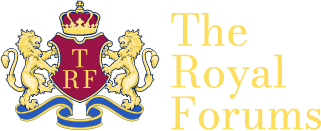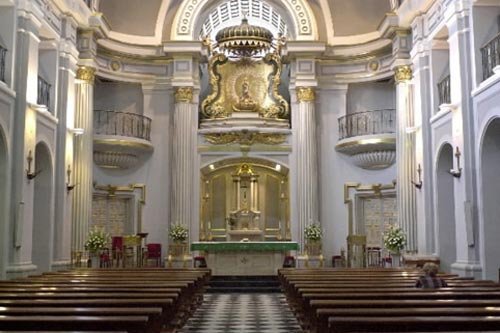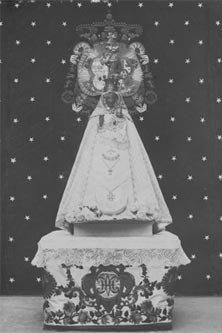lula
Imperial Majesty
- Joined
- Apr 28, 2005
- Messages
- 20,400
- Country
- Spain
http://www.casareal.es/index.jsp
JUNE 7
Presentation of Her Royal Highness the Infanta Dona Leonor to Our Lady the Virgin of Atocha
Basílica of Our Lady of Atocha. Madrid
http://www.casareal.es/esp/cronicas/Acto.jsp?acto=3352
Their Royal Highnesses the Princes of Asturias will give continuity to this tradition of the Royal Family
Brief notes on the Basilica of Our Lady of Atocha
As dedication, that of Virgin of Atocha is slightly usual in Spain, so diverse where they are the Marian names. Nevertheless, in Madrid it has basilica as mistress, not declared, of the Court. It is not exact that she is copatrona from Madrid.
Felipe III institutes in 1602 the basilica and other establishments placed around her as Royal Patronage, entrusted since then the Preachers' Order in order to inform suffrages for the King and to attend to social functions . He saved itself, besides, the right to be buried in this temple (the construction of the Kings' Pantheon of the Monastery of El Escorial was stopped then by technical problems). For this reason, the charges and rights of Patronage correspond to National wealth (Law 23/1982).
Royal devotion
Isabel II was a queen close all that she was identifying with the people of Madrid, and from her adult age (1843), added new devotions to the Virgin of Atocha, since to come every Saturday to the prayer of the Salve when the Court was in Madrid (November - March), and to present the Infantes a few days after being born.
In spite of this devotion, the queen married in the chapel of the Royal Palace (1846). Nevertheless, Alfonso XII would find in Atocha the space for guests who were demanding the new social customs, and that the Royal Chapel was lacking.
Phases of the basilica
The history of the sanctuary of Our Lady of Atocha (basilica after the Concordat of 1851) is not documented well and the news previous to the institution of the Royal Patronage is confused and fragmentary.
With regard to the building, the following steps can be distinguished:
Felipe III gives the orders to construct a chapel for the Virgin the famous Juan Gómez de Mora, placed parallel to the church of the convent.
Felipe IV rebuilds, from 1649, the dressing-room of the Virgin, to which Carlos II provides with fresh air painted by Lucas Jordán. In 1808, during the French occupation, the interior of the temple and of the chapel they remain satiny. The architect Isidro Gonzalez Velázquez unifies chapel and temple.
Patches and arrangements do not avoid a deterioration that in 1885 leads to the demolition of the factory. Dona Maria Cristina summons in 1890 a contest to build a great suitable temple for ceremonies of State, which Fernando Arbós gains. Only he concluded the campanile and a part of the cloister (today Pantheon of Illustrious Men).
The Preachers' Order tackles to its expenses in 1924 the construction of a convent and basilica, according to project of Francisco Antón, of style seudobarroco.
Destroyed the previous one in 1936, the current one is a work of Diego Méndez (1951). In the rest of the plot not occupied by the temple, National wealth built a college (Ramon Andrada), inaugurated in 1970.
Prominent events
The Prince of Asturias (future Carlos IV) and his wife, Maria Luisa of Parma, celebrate mass of watches, with great solemnity and device on December 11, 1765.
The Prince of Asturias (future Fernando VII) visit Atocha, on July 19, 1803, with his first wife, Maria Antonia de Borbón. Fernando VII and Maria Josefa Amalia of Saxony, after the watches, come to the sanctuary on October 21, 1819.
Fernando VII and Maria Cristina de Borbón celebrate velaciones on December 12, 1829.
The Queen Isabel II, on the following day of her marriage in the Royal Palace, celebrates watches on October 11, 1846.
Isabel II inaugurates the pious habit of offering the Virgin of Atocha the born Infantes alive (1852).
The King Alfonso XII celebrates in this basilica his two weddings: on January 23, 1878, with Dona Maria de las Mercedes de Orleáns; and on November 29, 1879, with Dona Cristina of Austria. The courtship was the most solemn.
Don Alfonso XIII presides on the first Saturday of November, 1926 at the movement of the image from the Royal Patronage of the Good Event to Atocha's basilica.
Don Juan Carlos, Prince at the time of Spain, there presents the Virgin to his children the Prince of Asturias (1968), and the Infantas Dona Elena (1963) and Dona Cristina (1965).
Her Royal Highnesses the Princes of Asturias, in the day of their wedding, May 22, 2004, realized a floral offering.
JUNE 7
Presentation of Her Royal Highness the Infanta Dona Leonor to Our Lady the Virgin of Atocha
Basílica of Our Lady of Atocha. Madrid
http://www.casareal.es/esp/cronicas/Acto.jsp?acto=3352
Their Royal Highnesses the Princes of Asturias will give continuity to this tradition of the Royal Family
Brief notes on the Basilica of Our Lady of Atocha
As dedication, that of Virgin of Atocha is slightly usual in Spain, so diverse where they are the Marian names. Nevertheless, in Madrid it has basilica as mistress, not declared, of the Court. It is not exact that she is copatrona from Madrid.
Felipe III institutes in 1602 the basilica and other establishments placed around her as Royal Patronage, entrusted since then the Preachers' Order in order to inform suffrages for the King and to attend to social functions . He saved itself, besides, the right to be buried in this temple (the construction of the Kings' Pantheon of the Monastery of El Escorial was stopped then by technical problems). For this reason, the charges and rights of Patronage correspond to National wealth (Law 23/1982).
Royal devotion
Isabel II was a queen close all that she was identifying with the people of Madrid, and from her adult age (1843), added new devotions to the Virgin of Atocha, since to come every Saturday to the prayer of the Salve when the Court was in Madrid (November - March), and to present the Infantes a few days after being born.
In spite of this devotion, the queen married in the chapel of the Royal Palace (1846). Nevertheless, Alfonso XII would find in Atocha the space for guests who were demanding the new social customs, and that the Royal Chapel was lacking.
Phases of the basilica
The history of the sanctuary of Our Lady of Atocha (basilica after the Concordat of 1851) is not documented well and the news previous to the institution of the Royal Patronage is confused and fragmentary.
With regard to the building, the following steps can be distinguished:
Felipe III gives the orders to construct a chapel for the Virgin the famous Juan Gómez de Mora, placed parallel to the church of the convent.
Felipe IV rebuilds, from 1649, the dressing-room of the Virgin, to which Carlos II provides with fresh air painted by Lucas Jordán. In 1808, during the French occupation, the interior of the temple and of the chapel they remain satiny. The architect Isidro Gonzalez Velázquez unifies chapel and temple.
Patches and arrangements do not avoid a deterioration that in 1885 leads to the demolition of the factory. Dona Maria Cristina summons in 1890 a contest to build a great suitable temple for ceremonies of State, which Fernando Arbós gains. Only he concluded the campanile and a part of the cloister (today Pantheon of Illustrious Men).
The Preachers' Order tackles to its expenses in 1924 the construction of a convent and basilica, according to project of Francisco Antón, of style seudobarroco.
Destroyed the previous one in 1936, the current one is a work of Diego Méndez (1951). In the rest of the plot not occupied by the temple, National wealth built a college (Ramon Andrada), inaugurated in 1970.
Prominent events
The Prince of Asturias (future Carlos IV) and his wife, Maria Luisa of Parma, celebrate mass of watches, with great solemnity and device on December 11, 1765.
The Prince of Asturias (future Fernando VII) visit Atocha, on July 19, 1803, with his first wife, Maria Antonia de Borbón. Fernando VII and Maria Josefa Amalia of Saxony, after the watches, come to the sanctuary on October 21, 1819.
Fernando VII and Maria Cristina de Borbón celebrate velaciones on December 12, 1829.
The Queen Isabel II, on the following day of her marriage in the Royal Palace, celebrates watches on October 11, 1846.
Isabel II inaugurates the pious habit of offering the Virgin of Atocha the born Infantes alive (1852).
The King Alfonso XII celebrates in this basilica his two weddings: on January 23, 1878, with Dona Maria de las Mercedes de Orleáns; and on November 29, 1879, with Dona Cristina of Austria. The courtship was the most solemn.
Don Alfonso XIII presides on the first Saturday of November, 1926 at the movement of the image from the Royal Patronage of the Good Event to Atocha's basilica.
Don Juan Carlos, Prince at the time of Spain, there presents the Virgin to his children the Prince of Asturias (1968), and the Infantas Dona Elena (1963) and Dona Cristina (1965).
Her Royal Highnesses the Princes of Asturias, in the day of their wedding, May 22, 2004, realized a floral offering.
Attachments
Last edited:



















